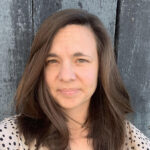1
Greetings
Hannah D. Markley, Editor
Class of 2023
Greetings

Hannah D. Markley
Editor
Class of 2023
I have a minor confession to make: I was sixteen before I walked into an art museum for the first time. I grew up in a small town in southern Illinois, and art museums weren’t my family’s preferred way to spend a day. So, it wasn’t until I was in Washington, D.C., with a free afternoon on a trip with my church youth group that a few friends and I wandered into the Smithsonian American Art Museum.
Why did we choose the art museum that day of all the museums on the Mall? Maybe I was thinking about Van Gogh or Picasso, the few artists I would have known from school at the time. Beyond that, I believe I was searching for an experience that I wouldn’t be able to get in our small town in the Midwest. Art seemed like the furthest from what I knew, a sophisticated way to spend a few hours in the city.
The large entrance echoed with the click of heels and squeaky tennis shoes. I had nothing I particularly wanted to see, but I took a map, unfolded it, and pretended I might know along with everyone else. Galleries full of paintings opened to the front, the right, and the left, and, even with the map in my hand, the first thing that came out of my mouth was: “Are all these real?”
I’m not sure where I thought “real” paintings were kept, or what, if the paintings weren’t genuine, they actually displayed in museums. One friend smiled and responded to my unknowing question by leading me into a wide hallway lit brightly by a glass ceiling, and for an hour or two we moved through the galleries and stared at paintings.
I don’t recall any specific artists or works from that day, but what I do remember is how I came away from that afternoon giddy. The galleries immersed me in a world that I did not yet have a language for, but even without words, what I saw transcended what I had known of art—a poster of Van Gogh’s “Sunflowers” or a page on “Guernica” in a history book—into an embodiment of wonder, a kind of holiness. The rest of the trip, I was a convert, keen to tell everyone who asked about the spell of the place.
In this issue, Nabokov and Carmen Maria Machado work their magic on Adrianne Harun and guide her back to a love for reading in her craft essay, “Enchanted Fragments.” Keats Chaves, Soundings’s Contributing Writer, interviews Katie Duane about her Outside Experience, a project combining text and her visual art. Lastly, we have reflections from the 2021 Bread Loaf Conference attendees—Liz Culpepper, Shawna Ervin, Lynette Vialet, and Preeti Parikh—in “So Little Is a Stone.”
We are also eager to share with you the work and many accomplishments from writers in our community in Publications, Announcements, Opportunities, and Literary Citizenship.
Wishing you all well as spring begins, and thank you for your support of and contributions to Soundings!
Hannah D. Markley
